

Social impact of thong underwear. Overview[edit] When discussing the trend of wearing thongs Sharon Daugherty comments in her book What Guys See That Girls Don't: Or Do They?
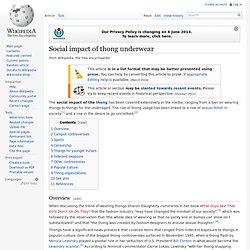
That the fashion industry "may have changed the mindset of our society",[3] which was followed by the observation that "the whole idea of wearing so that no panty line or bumps can show isn't substantiated" and that "the thong was created by fashion designers to arouse sexual thoughts".[4] Thongs have a significant news presence that covered items that ranged from indecent exposure to thongs in popular culture. One of the biggest thong controversies surfaced in November 1995, when a thong flash by Monica Lewinsky played a pivotal role in her seduction of U.S. President Bill Clinton in what would become the Lewinsky scandal.[5] According to feminist commentator Carrie Lukas, Lewinsky "with her thong-snapping seduction, forever changed the image of the D.C. junior staffer from aspiring policy wonk to sexual temptress Marketing analysts Marian L.
Posture collar. Cowboy boot. Cowboy boots refer to a specific style of riding boot, historically worn by cowboys.
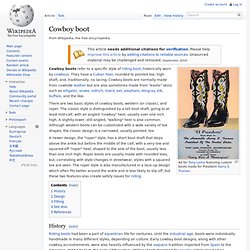
They have a Cuban heel, rounded to pointed toe, high shaft, and, traditionally, no lacing. Cowboy boots are normally made from cowhide leather but are also sometimes made from "exotic" skins such as alligator, snake, ostrich, lizard, eel, elephant, stingray, elk, buffalo, and the like. There are two basic styles of cowboy boots, western (or classic), and roper.
The classic style is distinguished by a tall boot shaft, going to at least mid-calf, with an angled "cowboy" heel, usually over one inch high. Swimsuit. American 1920s woman's bathing suit A swimsuit, bathing suit, swimming costume, swimming suit, swimmers, tog, bathers, or cossie (short for "costume"), or swimming trunks for men, is an item of clothing designed to be worn by people engaging in a water-based activity or water sports, such as swimming, water polo, diving, surfing, water skiing, or during activities in the sun, such as sun bathing. Different types are worn by men, women, and children. A swimsuit can be worn as an undergarment in sports that require a wetsuit such as water skiing, scuba diving, surfing, and wakeboarding. Swimsuits are also worn when there is a need to display the body, as in the case of beauty pageants or bodybuilding contests. Glamour photography and magazines like the annual Sports Illustrated Swimsuit Issue feature models and sports personalities in swimsuits.
Briefs. Front and rear view of traditional men's briefs.
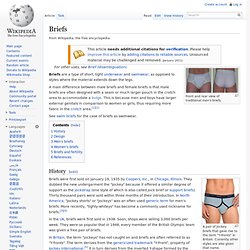
Briefs are a type of short, tight underwear and swimwear, as opposed to styles where the material extends down the legs. A main difference between male briefs and female briefs is that male briefs are often designed with a seam or much larger pouch in the crotch area to accommodate a bulge. This is because men and boys have larger external genitals in comparison to women or girls, thus requiring more fabric in the crotch area.[1][2] See swim briefs for the case of briefs as swimwear. History[edit] A pair of Jockey briefs that gave rise to the term "Y-fronts" in Britain. Loincloth. A form of loincloth worn with a cape by an Aztec ruler, circa 1500 History and types[edit] Loincloths are being and have been worn: in societies where no other clothing is needed or wantedas an undergarment or swimsuitby the farmers in paddy fields in Sri Lanka and India, especially when they are working with mud.
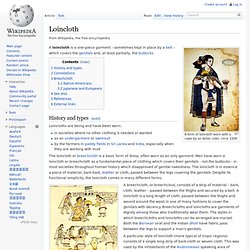
Leather. Modern leather-working tools Leather is used for various purposes including clothing, bookbinding, leather wallpaper, and as a furniture covering.
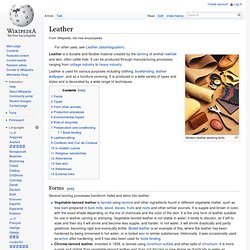
It is produced in a wide variety of types and styles and is decorated by a wide range of techniques. Forms[edit] Several tanning processes transform hides and skins into leather: Leather—usually vegetable-tanned—can be oiled to improve its water resistance. Leather with the hair still attached is called hair-on. Kirtle. The luteplayer wears a kirtle over her smock, 1626.

Kirtles were part of fashionable attire into the middle sixteenth century, and remained part of country or middle-class clothing into the seventeenth century. Kirtles began as loose garments without a waist seam, changing to tightly fitted supportive garments in the 14th century. Later kirtles could be constructed by combining a fitted bodice with a skirt gathered or pleated into the waist seam. Kirtles could lace up the front, back or side-back, with some rare cases of side lacing, all depending on the fashion of the day/place and what kind of gown was to be worn over it. Kirtles could be embellished with a variety of decorations including gold, silk, tassels, and knobs.[1] See also[edit] References[edit] Arnold, Janet: Queen Elizabeth's Wardrobe Unlock'd, W S Maney and Son Ltd, Leeds 1988.
Chemise. Fashionable young man in early 16th century Germany showing a lot of fine linen in a studied negligee.

This gentleman has a band of "smocking" round the collar of his shift. The term chemise or shift can refer to the classic smock, or else can refer to certain modern types of women's undergarments and dresses. In the classical usage it is a simple garment worn next to the skin to protect clothing from sweat and body oils, the precursor to the modern shirts commonly worn in Western nations. Etymology[edit] Chemise is a French term (which today simply means shirt). Modern chemise[edit] Kimono. Not to be confused with Kemono.
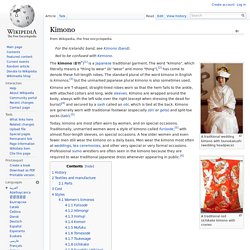
A traditional wedding kimono with tsunokakushi (wedding headpiece) A traditional red Uchikake kimono with cranes The kimono (着物?) [1] is a Japanese traditional garment. The word "kimono", which literally means a "thing to wear" (ki "wear" and mono "thing"),[2] has come to denote these full-length robes. Catsuit. Catsuits, which date from at least the 1940s, can be worn by both men and women, and, despite the name, do not generally have feline characteristics.
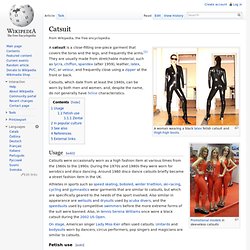
Usage[edit] Catsuits were occasionally worn as a high fashion item at various times from the 1960s to the 1990s. During the 1970s and 1980s they were worn for aerobics and disco dancing. Around 1980 disco dance catsuits briefly became a street fashion item in the UK. Lingerie. Assorted lingerie styles Lingerie are women's undergarments, and may imply their being fashionable and alluring .

Lingerie includes undergarments using flexible, stretchy, sheer, or decorative materials like Lycra, nylon (nylon tricot), polyester, satin, lace, silk and sheer fabric. Certain cotton or synthetic undergarments are also lingerie. Cowboy hat. Tailcoat. A tailcoat is a coat with the front of the skirt cut away, so as to leave only the rear section of the skirt, known as the tails. The historical reason coats were cut this way was to make it easier for the wearer to ride a horse, but over the years tailcoats of varying types have evolved into forms of formal dress for both day and evening wear. Although there are several different types of tailcoat, the term tailcoat is popularly taken to be synonymous with the type of dress coat still worn today in the evening with white tie.
This dress coat, one of the two main surviving tailcoats, is a dark evening coat with a squarely cut away front. The other one is the morning coat (or cutaway in American English), which is cut away at the front in a gradual taper.
Dress. A dress (also known as a frock or a gown) is a garment consisting of a skirt with an attached bodice (or a matching bodice giving the effect of a one-piece garment). In Western culture, dresses are usually considered to be items of women's and girls' apparel. The hemlines of dresses vary depending on the whims of fashion and the modesty or personal taste of the wearer.[1] History[edit] 19th century[edit] Dresses increased dramatically to the hoopskirt and crinoline-supported styles of the 1860s; then fullness was draped and drawn to the back.
Shorts. Shorts are a garment worn by both men and women over their pelvic area, circling the waist and splitting to cover the upper part of the legs, sometimes extending down to knee but not covering the entire length of the leg. They are called "shorts" because they are a shortened version of pants, which cover the entire leg. Shorts are typically worn in warm weather or in an environment where comfort and airflow are more important than the protection of the legs. There are a variety of shorts, ranging from knee-length short pants that can be worn as formal clothes to beachwear and athletic shorts. Windbreaker. A windbreaker with its stowable hood outside. Rissman company ad for windbreaker jackets. Panties. Panties in different colours Panties (typically called knickers in British English) are a form of underwear designed to be worn by women and girls[1] in the crotch area below the waist. History[edit] Miniskirt. Sweatpants. Three boys wearing grey sweatpants.
Nightgown. Bodice. A bodice (American English /ˈbɑːdɨs/, British /ˈbɒdɪs/) historically, is an article of clothing for women, covering the body from the neck to the waist. Hobble skirt. A postcard (circa 1911) depicting a man pointing at a woman wearing a hobble skirt. Undergarment. Undergarments are clothes worn under other clothes, often directly next to the skin. Latex clothing. Latex rubber is used in many types of clothing. Rubber has traditionally been used in protective clothing, including gas masks and Wellington boots. Rubber is now generally being replaced in these application by plastics. Mackintoshes have traditionally been made from rubberized cloth. Wonderbra.